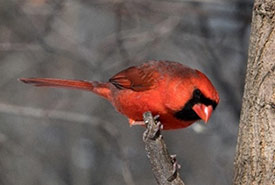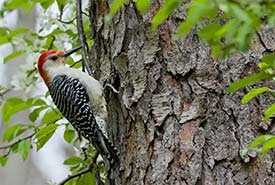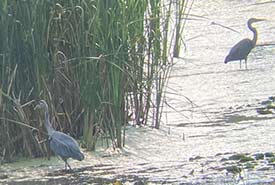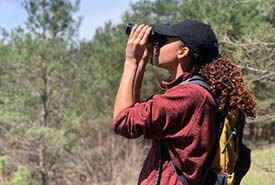The dos and don’ts of birdwatching

Northern cardinal (Photo by NCC)
The creation of my high school’s birdwatching club sparked a passion in me that has lasted years following graduation. The excitement of seeing a new species for the first time was contagious and something I continue to seek, to this day. I used to think that birdwatching was an activity for retired people who had nothing else to do, but I quickly learned that it was a great way to connect with nature, and it has become a favourite hobby of mine. Whether at a conservation area or in your own backyard, birdwatching (or birding) is a truly captivating pastime.
Here are some dos and don’ts to keep in mind the next time you’re out watching some feathered friends.
Do take pictures!

Red-bellied woodpecker (Photo by NCC)
Birds are gorgeous to look at, especially during breeding season. They have unique feathers, bright colours, and they know how to pose. Taking pictures lets you share the beauty of birds with others and gives you something to look back on. While looking up at the trees, be careful that you don’t trip on anything, and keep an eye out for waterfowl and grassland species as well. You can take pictures using your phone’s camera or an SLR camera. An easy way to pick out birders in a crowd of hikers is to look for the people with very long zoom lenses.
Don’t invade the personal space of wildlife

A picture of two great blue herons at Lynde Shores Conservation Area, ON. (Photo by Misha Golin/NCC staff)
I get it. Birds can be so alluring sometimes you just want to reach out and touch them, or even just get as close to them as possible. These actions, however, are frowned upon. Birds are wild animals, and they can be unpredictable and easily stressed. Disturbances can force birds out of their nests and expose them to predators or distract them from catching a meal themselves. Avoiding humans also uses up valuable energy, especially in the winter months when food is scarce. Make sure that when you are observing birds you are not disrupting important behaviours, such as hunting and foraging, courting, raising of young and nest building. Try not to overcrowd them or give up the location of rare birds to large community groups. Of course, we would all love to see a peregrine falcon or cerulean warbler up close, but bringing too much traffic and human presence can cause problems and deter species from returning. If you notice a bird is changing its behaviour because of your proximity to it, that is a signal to move farther away. For the safety and well-being of the birds, and to keep them around, respect their space. Using binoculars or a camera allows you to view birds from a distance. For more information, visit the Code of Birding Ethics by Birds Canada.
Do bring the necessary equipment

Picture of Misha Golin using a pair of binoculars to see an eastern phoebe (Photo by Jaide Wilkinson)
I can remember multiple occasions that I have forgotten my binoculars at home and kicked myself for it. Seeing birds from far away is still nice, but a zoomed-in view makes them easier to identify and admire. My pair of binoculars was gifted to me by a friend who bought them from an auction. You can buy binoculars at your local nature store, online or try to thrift a pair if you can find some in good condition!
Another good thing to have on hand is some form of field guide. I highly recommend the Merlin Bird ID app; it can help you pinpoint species through photo and sound ID. It also keeps track of a "life list" of all the birds you have identified and narrows down observations through a series of questions. If you’re more into paper books, the Peterson Field Guide to Birds is one of my favourites and features beautiful illustrations.
Do keep dogs leashed and only in areas they are allowed
I love taking my dog along on hikes, especially to off-leash parks, but I never bring him to places where I know dogs are not allowed. In natural areas that include bird habitat, bringing a dog can cause stress and potential harm to birds. They can be loud or even aggressive toward wildlife, and these incidents should be avoided at all costs. If you are not sure about the rules of where you are birdwatching, check online to see if dogs are permitted. Make sure to follow the rules of the conservation area to respect nature and the species that live there.
Do bring friends
Birdwatching is a wonderful way to connect with members of your community who share a similar interest, while getting to spend time outside. It is especially rewarding to introduce people to the world of birds, who may not have been otherwise interested, and to see their knowledge grow! My boyfriend knew nothing about birds, but can now name almost every species we see on walks around our neighbourhood. My parents hated the grackles in our backyard and thought the birds were a nuisance, but can now appreciate the local songbirds and they feed them every winter.
Sharing your love of nature with others is easy to do through birdwatching, as opportunities present themselves constantly outdoors. Whether in a city or a forest, various species of birds can be seen throughout the year. On NCC properties, during species inventories and bird surveys, staff make sure to respect the boundaries of organisms and their habitat. We follow these tips to ensure the best outcomes while performing conservation work needed to protect birds and their environment.
I hope this encourages you to get out and see some of the wonderful winged species that Canada has to offer!


